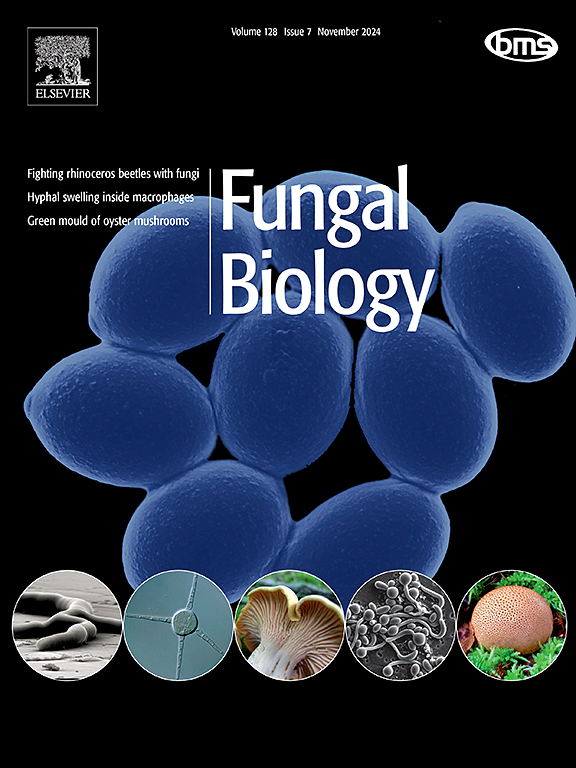Diversity and temporal succession of early-colonizing fungi in wood baits from an estuarine environment, with description of Penicillium alavariense sp. nov
IF 3
3区 生物学
Q2 MYCOLOGY
引用次数: 0
Abstract
Lignicolous marine fungi thrive in marine environments by colonizing wood, where they play a vital role in the degradation and recycling of complex molecules. However, lignicolous marine fungi remain under-described, with significant gaps in knowledge concerning their species diversity. To assess the diversity and temporal succession of lignicolous marine fungi, we submerged wood blocks of Pinus pinaster and Fagus sylvatica at the Ria de Aveiro estuary, Portugal and collected samples every two months, over six months. Twenty-nine fungal genera were identified from 251 isolates, with Penicillium being the most common genus after two months of block submersion. Wood type seems to have modulated fungal diversity, with several genera including Lulworthia spp. prefering beech wood, and Paralulworthia colonized pine. We showed that marine fungal genera from the family Lulworthiaceae are predominant and consistent colonizers of wood substrates in estuarine environments, occupying an intermediate role in colonization. In contrast, the genus Penicillium, the pioneer colonizer, decreases over time, likely due to competition with other marine genera. Based on multilocus phylogeny, using sequences of internal transcribed spacer region of the nuclear RNA gene cluster (ITS), and partial sequences of tubulin (tub2), calmodulin (cal) and RNA polymerase II (rpb2) coding genes’ sequences, and morphological data, we propose Penicillium alavariense sp. nov., as a novel species in the series Simplicissima. These findings provide new insights into fungal succession on wood substrates, highlighting the role of wood type in shaping fungal communities and advancing our understanding of nutrient cycling in estuarine ecosystems.
河口环境木饵中早期定殖真菌的多样性和时间演替,包括青霉菌alavariense sp. nov的描述
木质素海洋真菌在海洋环境中通过定植木材而茁壮成长,它们在复杂分子的降解和再循环中起着至关重要的作用。然而,木质素海洋真菌仍然未被充分描述,其物种多样性方面的知识存在显著差距。为了评估木质素海洋真菌的多样性和时间演替,我们在葡萄牙Ria de Aveiro河口淹没了Pinus pinaster和Fagus sylvatica木块,每两个月采集一次样本,为期6个月。从251株真菌中鉴定出29个真菌属,经过2个月的块状浸泡后,青霉菌是最常见的属。木材类型似乎调节了真菌的多样性,包括Lulworthia sp .喜欢山毛榉木在内的几个属,和副ulworthia定居松树。研究表明,陆氏科海洋真菌属是河口环境中木材基质的主要和一致的定殖菌,在定殖过程中起着中间作用。相比之下,青霉菌属,开拓者,随着时间的推移而减少,可能是由于与其他海洋属的竞争。基于多位点系统发育,利用核RNA基因簇(ITS)内部转录间隔区序列、微管蛋白(tub2)、钙调蛋白(cal)和RNA聚合酶II (rpb2)编码基因的部分序列和形态学资料,我们提出alavariense sp. nov.是Simplicissima系列的新种。这些发现为真菌在木材基质上的演替提供了新的见解,突出了木材类型在真菌群落形成中的作用,并促进了我们对河口生态系统养分循环的理解。
本文章由计算机程序翻译,如有差异,请以英文原文为准。
求助全文
约1分钟内获得全文
求助全文
来源期刊

Fungal biology
MYCOLOGY-
CiteScore
5.80
自引率
4.00%
发文量
80
审稿时长
49 days
期刊介绍:
Fungal Biology publishes original contributions in all fields of basic and applied research involving fungi and fungus-like organisms (including oomycetes and slime moulds). Areas of investigation include biodeterioration, biotechnology, cell and developmental biology, ecology, evolution, genetics, geomycology, medical mycology, mutualistic interactions (including lichens and mycorrhizas), physiology, plant pathology, secondary metabolites, and taxonomy and systematics. Submissions on experimental methods are also welcomed. Priority is given to contributions likely to be of interest to a wide international audience.
 求助内容:
求助内容: 应助结果提醒方式:
应助结果提醒方式:


